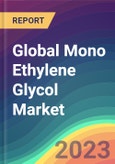Mono Ethylene Glycol (MEG) is a versatile industrial chemical with high demand owing to its properties such as high durability, hydrophobic nature, and extreme tenacity. It is keenly used as a key ingredient or as a feedstock for manufacturing a variety of products such as Polyester Fibres, Polyester Films, Polyethylene Terephthalate (PET), antifreeze products, Coolants, solvents, etc. Additionally, it is employed in paper, printing inks, leather, fibres treatment and cellophane industries due to its humectant nature. Owing to all these applications, the major end use industries of MEG are Textile, Packaging, Cosmetics, Pharmaceuticals, Food and Beverage, Automobile, Chemicals, Adhesives & Sealants, and Others. Most of the MEG produced globally is utilized in the production of Polyester Fibers followed by Polyethylene Terephthalate (PET) and Polyester films.
Regionally, the Asia Pacific region is dominating the Mono Ethylene Glycol (MEG) market followed by Europe. This region held a market share of approximately 45% in 2022. Because of the strong demand of MEG from developing countries like China and India along with flourishing textile and rubber industry, the Asia Pacific region will most likely continue to dominate the global market.
Based on the end-user industry, the global Mono Ethylene Glycol (MEG) market is segmented into Polyester Fibre and Yarn, PET Resin, Polyester Film, and Others. Among these, Polyester Fibre and Yarn industry is dominating the Mono Ethylene Glycol (MEG) market and held roughly 58% of the market in 2022. Due to its capacity to lower the freezing temperature of water, mono ethylene glycol is primarily used in the antifreeze industry as a component in the production of antifreeze, coolants, aircraft anti-icers, and deicers. Furthermore, mono ethylene glycol is used in the production of alkyd resins, which are utilised in paints, enamels, and varnishes to produce a film. To prevent the formation of clathrates, MEG is also employed here as a desiccant in petrol pipelines.
Major players in the production of Global Mono Ethylene Glycol (MEG) are SABIC, ExxonMobil Corporation, Mitsubishi Chemical, Formosa, Chemtex Speciality Limited, The Dow Chemicals, LyondellBasell Industries, Royal Dutch Shell, AkzoNobel, MEGlobal, Reliance Industries, Lotte Chemical Corporation, Nan Ya Plastics Corporation, China Petroleum and Chemical Corporation, India Glycols and Sinopec Zhenhai Refining & Chemical Co.
Years considered for this report:
- Historical Period: 2015- 2022
- Base Year: 2022
- Estimated Year: 2023
- Forecast Period: 2024-2030
Objective of the Study:
- To assess the demand-supply scenario of Mono Ethylene Glycol (MEG) which covers production, demand and supply of Mono Ethylene Glycol (MEG) market in the globe.
- To analyse and forecast the market size of Mono Ethylene Glycol (MEG)
- To classify and forecast Global Mono Ethylene Glycol (MEG) market based on end-use and regional distribution.
- To examine competitive developments such as expansions, mergers & acquisitions, etc., of Mono Ethylene Glycol (MEG) market in the globe.
The publisher calculated Mono Ethylene Glycol (MEG) demand in the globe by analyzing the historical data and demand forecast which was carried out considering the raw materials to produce Mono Ethylene Glycol (MEG). The publisher sourced these values from industry experts and company representatives and externally validated through analyzing historical sales data of respective manufacturers to arrive at the overall market size. Various secondary sources such as company websites, association reports, annual reports, etc., were also studied by the publisher.
Key Target Audience:
- Mono Ethylene Glycol (MEG) manufacturers and other stakeholders
- Organizations, forums and alliances related to Mono Ethylene Glycol (MEG) distribution
- Government bodies such as regulating authorities and policy makers
- Market research organizations and consulting companies
Report Scope:
In this report, Global Mono Ethylene Glycol (MEG) s market has been segmented into following categories, in addition to the industry trends which have also been detailed below:- Market, by End-Use: Polyester Fibre and Yarn, PET Resin, Polyester Film, and Others
- Market, by Sales Channel: Direct Sale and Indirect Sale
- Market, by Region: North America, Europe, Asia Pacific, Middle East and Africa, and South America.








